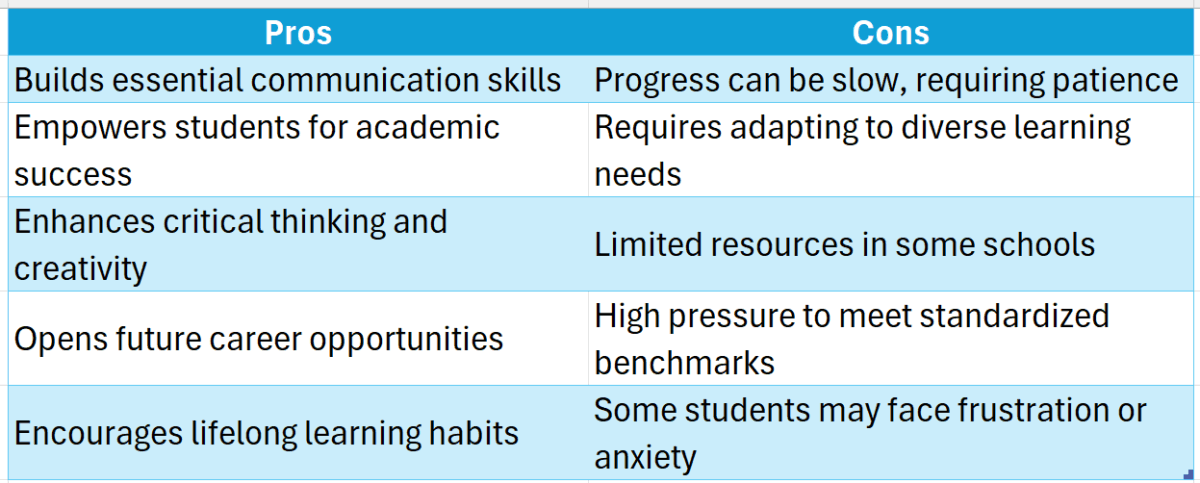
Literacy teaching is crucial in early education as it establishes the groundwork for a child’s future learning. Strong reading skills not only lead to academic success but also empower children to explore new ideas and cultures, making literacy vital for their development.
The Role of Community-Based Instruction
Community-based instruction enhances literacy by linking learning to real-life experiences. This method helps students recognize the relevance of reading in their daily lives, such as understanding street signs or menus, highlighting the importance of literacy in their community.
Benefits of Student-Centered Instruction
Student-centered instruction addresses the unique needs of each learner. Key benefits include:
- Engagement: Lessons that relate to students’ interests increase involvement.
- Personal Growth: Tailored instruction allows students to progress at their own pace.
- Confidence Building: As students improve, their reading confidence grows, motivating them to tackle more challenging texts.
By incorporating these strategies, educators can cultivate a rich literacy environment that nurtures strong reading skills in students.
Study smarter, not harder—Enroll online today!
What Are the Key Components of Effective Reading Instruction?

Effective literacy teaching is essential for developing strong reading skills in students, opening doors to knowledge and creativity. But what makes reading instruction truly effective? Let’s delve into the key components that can enhance the learning environment.
Student-Centered Instruction
A core element of effective reading instruction is student-centered instruction. This approach prioritizes the needs and interests of students, allowing teachers to tailor lessons to their preferences. Engaging students in this way makes reading enjoyable and meaningful.
Community-Based Instruction
Another important aspect is community-based instruction, which links reading lessons to real-life experiences. For example, exploring local history or community events makes lessons relatable and helps students appreciate the relevance of reading in their daily lives.
Consistent Practice and Feedback
Finally, consistent practice and feedback are crucial. Regular reading sessions paired with constructive feedback enable students to improve. Teachers should encourage goal-setting and celebrate progress, fostering a supportive atmosphere that promotes growth.
How to Create a Literacy-Rich Environment for Students
Creating a literacy-rich environment is essential for effective literacy teaching. When students are surrounded by books, engaging activities, and supportive peers, they develop strong reading skills. This environment not only fosters a love for reading but also encourages students to explore new ideas and perspectives.
Key Elements of a Literacy-Rich Environment
- Diverse Reading Materials: Include a variety of genres, such as fiction, non-fiction, and poetry, to cater to different interests.
- Community-Based Instruction: Involve local libraries and community centers to provide resources and activities that enhance reading skills.
- Student-Centered Instruction: Focus on students’ interests and needs, allowing them to choose reading materials that resonate with them.
By integrating these elements, you create a space where students feel motivated to read. Encourage discussions about books and provide opportunities for students to share their thoughts. This not only builds confidence but also strengthens their comprehension skills, making reading a fun and engaging experience.
Engaging Students: Techniques to Foster a Love for Reading
Literacy teaching is crucial for developing strong reading skills in students, unlocking a world of knowledge and creativity. This not only boosts their confidence but also prepares them for academic success. To engage students and foster a love for reading, consider the following techniques:
Create a Reading-Friendly Environment
- Cozy Reading Nooks: Establish comfortable spaces filled with books to encourage exploration of different genres.
- Diverse Book Selections: Provide a variety of books that reflect students’ interests and backgrounds, making reading relatable and exciting!
Incorporate Community-Based Instruction
- Local Authors: Invite local authors to share their stories, connecting students with their community and the power of storytelling.
- Field Trips: Organize visits to libraries or bookstores to spark curiosity and enthusiasm for reading.
Use Student-Centered Instruction
- Choice in Reading: Empower students by allowing them to choose what they read, making it feel less like a chore.
- Interactive Activities: Incorporate games and discussions around books to help students connect with the material and each other.
The Role of Phonics in Developing Strong Reading Skills
Literacy teaching is essential for helping students develop strong reading skills. When students can read well, they unlock a world of knowledge and creativity. One key component in this journey is phonics, which lays the foundation for understanding how letters and sounds work together. Let’s explore how phonics plays a vital role in building these skills.
Understanding Phonics
Phonics is all about connecting sounds with letters. By teaching students to recognize these connections, we empower them to decode words independently. This method is especially effective in community-based instruction, where students can practice reading in real-life contexts, making learning more relevant and engaging.
Benefits of Phonics in Literacy Teaching
- Improves Decoding Skills: Students learn to sound out words, boosting their confidence.
- Enhances Vocabulary: As they read more, their word bank grows, enriching their language skills.
- Supports Student-Centered Instruction: Phonics allows teachers to tailor lessons to individual needs, ensuring every student progresses at their own pace.
By focusing on phonics, we can create a solid reading foundation that benefits students for years to come.
How to Assess Reading Skills and Progress in Students?
Assessing reading skills is crucial in literacy teaching because it helps educators understand where students stand and how to support their growth. By using various methods, teachers can tailor their instruction to meet each student’s needs, ensuring they build strong reading skills effectively.
Methods of Assessment
- Observations: Watch students as they read aloud. This gives insight into their fluency and comprehension.
- Reading Tests: Standardized tests can provide benchmarks for progress.
- Informal Assessments: Use quizzes or discussions to gauge understanding in a relaxed setting.
Community-Based Instruction
Incorporating community-based instruction can enhance assessment. For example, engaging students in local reading programs can motivate them and provide real-world contexts for their skills. This approach not only assesses their reading abilities but also fosters a love for reading through community involvement.
Student-Centered Instruction
Remember, student-centered instruction is key! Involve students in setting their reading goals. This empowers them and makes assessments feel less daunting. Encourage them to reflect on their progress, which can boost their confidence and enthusiasm for reading.
Incorporating Technology in Literacy Teaching: Tools and Resources
Incorporating technology in literacy teaching is essential for building strong reading skills in students. With the right tools, educators can create engaging, interactive experiences that make learning to read fun and effective. By embracing technology, we can support diverse learning styles and foster a love for reading that lasts a lifetime.
Engaging Tools for Literacy Teaching
- E-books and Audiobooks: These resources provide students with access to a wide range of texts, catering to different interests and reading levels.
- Interactive Apps: Many apps offer games and activities that reinforce reading skills while keeping students entertained.
- Online Communities: Platforms that promote community-based instruction allow students to share their reading experiences and recommendations, enhancing their learning through collaboration.
Benefits of Student-Centered Instruction
Using technology in literacy teaching promotes student-centered instruction. This approach allows students to take charge of their learning, making choices about what they read and how they engage with texts. By integrating technology, teachers can tailor lessons to meet individual needs, ensuring every student can build strong reading skills effectively.
Study smarter, not harder—Enroll online today!
Strategies for Differentiating Instruction in Literacy Education
Literacy teaching is essential for developing strong reading skills in students, opening doors to knowledge and creativity. To ensure every student thrives, teachers can use effective strategies for differentiating instruction that cater to diverse learning needs.
Understand Your Students
Begin by understanding your students’ interests and reading levels. This enables student-centered instruction, allowing lessons to be tailored for engagement. For instance, if a student enjoys animals, provide reading materials related to wildlife.
Use Community-Based Instruction
Incorporating community-based instruction enhances literacy by connecting classroom learning to real-world experiences. Field trips to local libraries or museums can make reading more relevant and exciting.
Offer Varied Learning Activities
- Group Work: Foster collaboration through group reading activities.
- Choice Boards: Allow students to select their reading materials.
- Technology Integration: Utilize apps and online resources to accommodate different learning styles.
By applying these strategies, teachers can create a dynamic literacy environment that encourages growth and a love for reading.
How Can Parents Support Literacy Development at Home?
Literacy teaching is crucial for developing strong reading skills, which are vital for academic success. Parents significantly influence this process by supporting literacy development at home. By creating a rich reading environment, they can instill a lifelong love for reading.
Create a Reading Routine
Establishing a daily reading routine is essential. Set aside time each day for reading together, which helps students practice their skills and strengthens the parent-child bond. Consistency is key!
Use Community-Based Instruction
Incorporate community-based instruction into reading activities. Visit local libraries, attend storytime events, or join reading clubs. These experiences expose students to diverse literature and encourage community engagement, making reading more relevant and exciting.
Encourage Student-Centered Instruction
Support student-centered instruction by allowing your child to choose their reading materials. Whether it’s comics, novels, or magazines, letting them pick boosts motivation. Engage in discussions about their choices to deepen understanding and interest.
Discover How Scholarship.Education Can Enhance Your Literacy Teaching Approach
Literacy teaching is crucial for helping students develop strong reading skills. When students can read well, they unlock a world of knowledge and creativity. At Scholarship.Education, we believe that effective literacy instruction can transform lives, making it essential for educators to adopt innovative approaches that engage and inspire learners.
Embrace Community-Based Instruction
Community-based instruction connects students with their surroundings. By incorporating local stories, events, and resources, students see the relevance of reading in their lives. This approach not only boosts engagement but also fosters a sense of belonging, making literacy more meaningful.
Focus on Student-Centered Instruction
Student-centered instruction puts learners at the heart of the teaching process. Here’s how it can enhance literacy skills:
- Personalized Learning: Tailor lessons to meet individual needs.
- Active Participation: Encourage discussions and collaborative activities.
- Real-World Connections: Relate reading materials to students’ interests and experiences.
By focusing on these strategies, Scholarship.Education helps educators create a dynamic literacy environment that nurtures strong reading skills in students.
Study smarter, not harder—Enroll online today!
FAQs
1. What is literacy teaching?
Literacy teaching focuses on helping students develop reading, writing, speaking, and listening skills across all grade levels.
2. Why is literacy important in education?
Strong literacy skills are the foundation for all learning. They help students succeed in every subject and improve critical thinking and communication.
3. What qualifications do I need to become a literacy teacher?
Typically, you need a bachelor’s degree in education or English, a teaching license, and sometimes a specialized certification in reading or literacy.
4. What strategies are effective in literacy teaching?
Effective strategies include phonics instruction, guided reading, vocabulary development, writing workshops, and using diverse texts to engage students.
5. Can literacy teaching happen across all subjects?
Yes, literacy skills are taught in all subjects. Science, social studies, and math teachers also integrate reading and writing strategies into their instruction.
6. What is the role of a literacy coach?
A literacy coach supports teachers by providing strategies, resources, and training to improve students’ reading and writing skills across the school.





